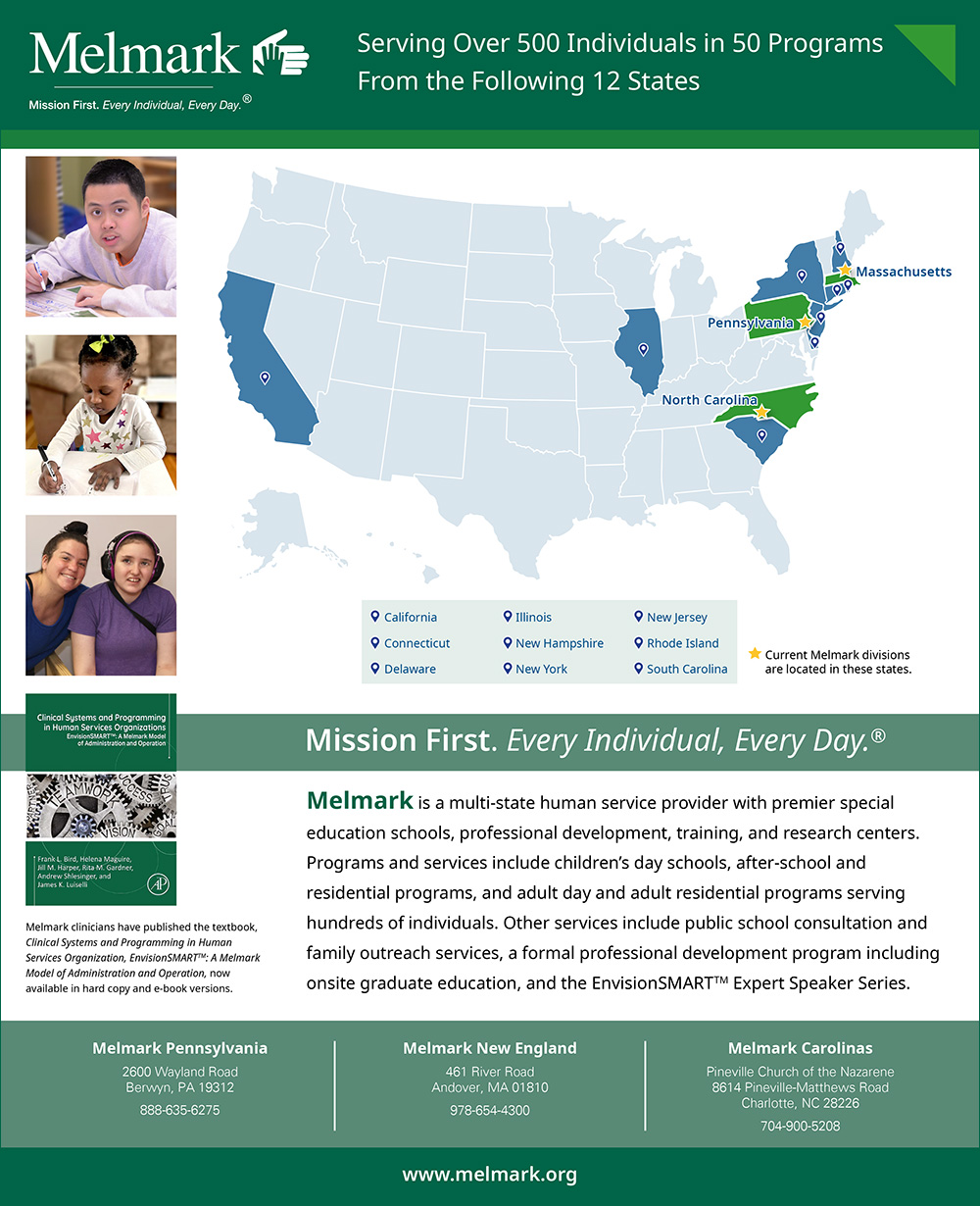Health care visits can be challenging for individuals with autism and the delivering providers. It is critical that we prepare both the individual and the provider to increase the integrity of the visit and ensure a successful outcome.

When I took on my role as Senior Director of Healthcare Services at Melmark, I came primarily from a hospital setting and took my ease of access to my health care providers for granted. I scheduled my appointment, arrived at the designated time, and checked in with the receptionist. Next, I was escorted back to see the provider, was seen, and left with a visit summary and instructions for follow-ups. However, I soon discovered the roadblocks that individuals with autism spectrum disorder (ASD) and their care providers face. Now, imagine you are a family member or care provider of an individual with ASD who requires a medical appointment. The entire process looks a lot different for an individual with special needs. You schedule the appointment. You arrive and check in with your individual. Then, you are both brought back to the exam room, where your individual becomes anxious and has a behavior. The provider insists that they cannot complete the visit due to non-compliance. You both are sent on your way without any treatment or answers.
Unfortunately, this scenario is all too common in the special needs world. Family and care providers report difficulties finding medical providers who “accept” those diagnosed with autism, being banned from providers’ offices due to behaviors, poor interactions with providers, and subpar medical exams and treatments. Thankfully, the Americans with Disabilities Act (ADA) offers federal protection against disability discrimination. This Act calls for providers to provide accommodation for individuals with disabilities, including reasonable modifications of policies and procedures, effective communication, and facility accessibility. Ways providers can modify policies and procedures are by providing earlier appointments when the office is less crowded, allowing staff to complete paperwork for those who have difficulties, and allowing companions and service animals to accompany individuals to their appointments. Stronger communication methods may need to be explored for some situations. Interpretation services, simple large-print instructions, and digital access to health information are some ways this can be achieved. In terms of facility accessibility, there are several ways to meet this requirement. Making parking, offices, bathrooms, and exam rooms ADA assessable, as well as clearing floor space for maneuverability, are a few ways to achieve this (Health Care and the Americans with Disabilities Act, n.d.).
The Affordable Care Act does give some reprieve of health insurance restraints to those with autism. According to the US Department of Health and Human Services website, the Act bans the exclusion of individuals with autism from health insurance, as well as banning lifetime dollar amounts for most services. In addition, health insurance must cover preventative services and autism screenings (The Affordable Care Act and Autism and Related Conditions, n.d.).
Individuals with autism face a lifetime of medical treatment needs for conditions such as gastrointestinal issues, metabolic disorders, autoimmune disorders, and sleep disorders, among others, in addition to receiving autism services. It is imperative that barriers to medical services be eliminated to foster healthy experiences and, therefore, constant treatment. According to the Children’s Hospital of Philadelphia, “reducing negative experiences in a medical setting during childhood makes it more likely that individuals with ASD receive appropriate preventive medical care throughout their lifetime and that adults with ASD will continue to make and keep regular medical appointments (Children’s Hospital of Philadelphia, 2017).”
Studies have found that integrated settings increase service access and enhance patient/family satisfaction. Bundling services together at one location can more easily accommodate multiple visits in one day, as well as offering a structured and familiar environment that can be comforting for many individuals with ASD. An integrated setting increases access to dental services, behavioral health, medical specialties such as neurology and gastroenterology, and therapeutic services such as speech and occupational therapy. During primary care visits, providers can use the shared electronic health record to see when patients are due for other services and more easily facilitate the scheduling of those appointments (Siasoco et al., 2017).
So, what can we do to ensure our individuals with special needs, particularly those with autism, receive the care they need? We must advocate for our individuals to receive the same access as the general population. Below are some helpful tips for caregivers and health care providers to navigate health care visits for an individual with ASD.
Tips for Caregivers for Health Care Visits:
- Meet with the provider’s office prior to the visit to ensure they are aware of the individual’s special needs. Extra time might need to be added to the appointment.
- Check with the provider to see when their office is least busy, and schedule appointments during those times to minimize distractions.
- Be aware of your rights. Those individuals with mental and physical disabilities have a right to the same health care visit access as anyone else.
- Complete paperwork and questionnaires in advance to minimize wait times.
- Prepare your individual for the visit by discussing what might happen. It might be beneficial to visit the office prior to the appointment to help prepare their individual.
- Ensure that appropriate support is available. Extra caregivers or office staff might need to assist during the visit.
- Make sure a preferred family member or staff is present to offer comfort and support to the individual during the appointment.
- Bring distractions, preferred items, rewards/reinforcers, and any communication devices the individual uses
- Work with a care navigator to coordinate services. Some insurance companies and medical offices employ care navigators who will work with individuals and caregivers to obtain prior authorizations for services, as well as find providers who offer pre-sedation or general anesthesia for testing and procedures.
Tips for Providers:
- Stay up to date with education and training related to those with autism or other special needs. Many are not aware of the behaviors that those with autism might display, nor are they aware of common co-morbidities these individuals face.
- Hold special needs run-through drills to take staff through a visit with an individual with autism. This will give staff a chance to prep and problem-solve prior to the visit.
- Have a designated quiet area where individuals can wait for the exam room to become available.
- Keep a sensory toolkit of toys (squishy, light-up, or spinning) and games ready in your office and have it handy in case a distraction or soothing prop is needed for an anxious individual.
- Allow extra time for appointments. Go slow and take some extra time if needed for breaks or to help patients acclimate to the environment or procedures.
- Explain everything you are doing using simple terms and pictures.
- Bundle services by having multiple specialties, such as vision, dental, psychology, and phlebotomy, available for each visit.
- Ensure individuals have a smooth transition to adulthood in terms of services. Pediatric providers will need to help individuals and caregivers source quality adult medical providers and provide a warm handoff to the new provider.
- Listen to the staff, caregivers, and parents who are accompanying the individual to the appointment. They know the individual the best and can provide guidance and insights into understanding the individual’s profile.
Mamie Richiutti, MS HAD/HED, BSN, RN, CEN, is Senior Director of Healthcare Services at Melmark PA.
References
Children’s Hospital of Philadelphia (2017, July 1). Tips for More Positive Office Visits for Patients with ASD. Children’s Hospital of Philadelphia. www.chop.edu/news/tips-more positive-office-visits-patients-asd
Health Care and the Americans with Disabilities Act. (n.d.). ADA National Network. https://adata.org/factsheet/health-care-and-ada
Siasoco, V., Cohen, R., & Bilello, R. (2017). Integrated Healthcare and Autism Spectrum Disorders. Autism Spectrum News, Summer 2017. source link.
The Affordable Care Act and Autism and Related Conditions. (n.d.). US Department of Health and Human Services. Retrieved February 6, 2024, from www.hhs.gov/programs/topic-sites/autism/aca-and-autism/index.html






